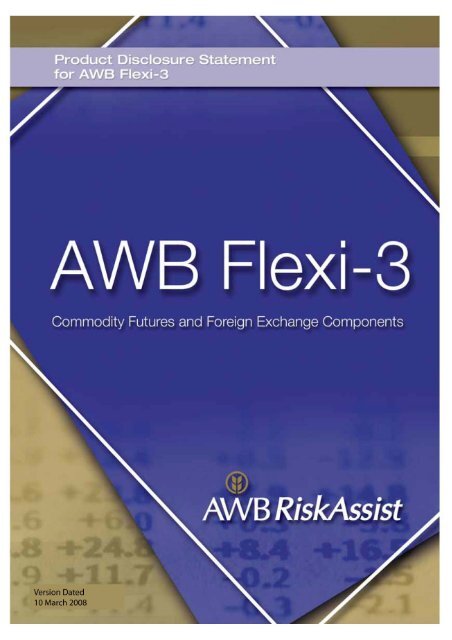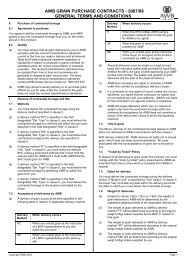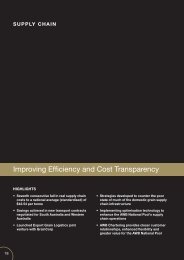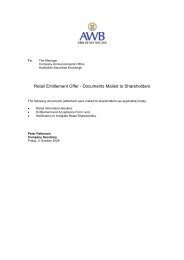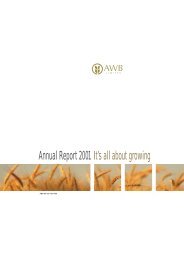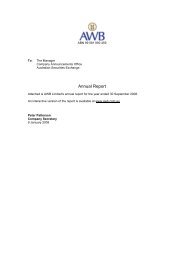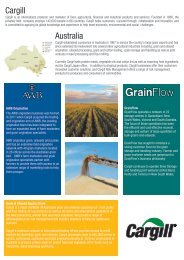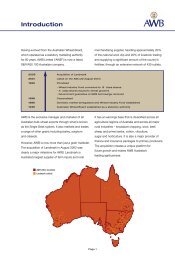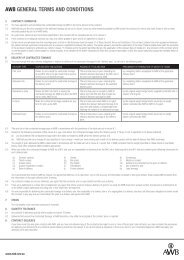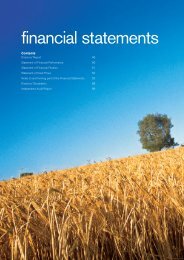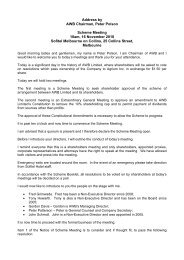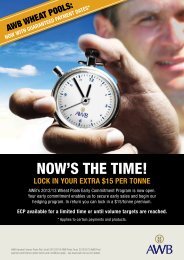RiskAssist Flexi3 Product Disclosure Statement - AWB Limited
RiskAssist Flexi3 Product Disclosure Statement - AWB Limited
RiskAssist Flexi3 Product Disclosure Statement - AWB Limited
Create successful ePaper yourself
Turn your PDF publications into a flip-book with our unique Google optimized e-Paper software.
Page 2
Contents1. About <strong>AWB</strong> <strong>RiskAssist</strong> 42. Our products 43. Introduction to futures and foreign exchange contracts 44. Futures and foreign exchange components of the contract 55. What are the benefits? 76. What are the risks? 77. Taxation considerations 88. The <strong>AWB</strong> appeals service 89. Important additional information 910. What do we mean by…? 911. Part 2 – Contract Schedule 11IMPORTANT NOTICEAbout this documentThis document is part of a <strong>Product</strong> <strong>Disclosure</strong> <strong>Statement</strong> (PDS) that relates to the <strong>AWB</strong> Flexi-3 contract that you canenter into with <strong>AWB</strong> <strong>RiskAssist</strong> <strong>Limited</strong> ABN 38 086 627 465, AFS Licence Number 244 128 (<strong>RiskAssist</strong>). The PDSfor the futures and foreign exchange components of the <strong>AWB</strong> Flexi-3 contract is comprised of this document and thecontract schedule (part 2 of this PDS), located at the back of this document.Changes to informationThis document is current as at 10 March 2008. Information in this PDS is subject to change from time to time. To theextent that the change is not materially adverse to customers, we may update it by posting a notice of the change onour website. A paper copy of any updated information will be given to you without charge on request. We may alsoissue a supplementary PDS with new information. This PDS (and any supplementary PDS) is available in paper formand in electronic form from the <strong>AWB</strong> <strong>RiskAssist</strong> website at www.riskassist.com.auYour decision to investThis PDS is an important document, which should be read in full before making a decision in relation to futures andforeign exchange positions. A document of this kind cannot take into account your own investment objectives, financialsituation or particular needs. Accordingly, nothing in this PDS is a recommendation by us or by any other personconcerning the futures and foreign exchange components of the <strong>AWB</strong> Flexi-3 contract. You should not only considerthe information in this PDS but also obtain independent financial and taxation advice as to the suitability of the futuresand foreign exchange components for you bearing in mind your investment objectives, financial situation and particularneeds.Page 3
1. About us1.1 About <strong>RiskAssist</strong>This PDS has been prepared by <strong>RiskAssist</strong> (referred toas we, us, our in this document). We offer price riskmanagement solutions across a range of agriculturalenterprises. These solutions allow you to manage yourcommodity and foreign exchange exposure. We issuecommodity futures and foreign exchange products inconnection with the deliverable grain contracts.Other factors will also affect the amount you are paid.For more details refer to part 2 of this PDS.This PDS relates to the futures and foreign exchangecomponents of the Contract. This PDS does not relateto, nor describe in detail, the basis component. A briefdiscussion of basis is set out in part 2 of this PDS inorder to give context to the discussion on the futures andforeign exchange components.We are a wholly owned subsidiary of <strong>AWB</strong> <strong>Limited</strong>(<strong>AWB</strong>) and part of the <strong>AWB</strong> Group.1.2 About the <strong>AWB</strong> GroupThe <strong>AWB</strong> Group is Australia's leading agribusiness andone of the world’s largest wheat managing andmarketing companies. Having evolved from theAustralian Wheat Board, which operated as agovernment statutory marketing authority for 60 years,<strong>AWB</strong> is now a listed Australian public company. <strong>AWB</strong> isthe exclusive manager and marketer of all Australianbulk wheat exports through what is known as the SingleDesk System. It also markets and trades a range ofother grains including barley, sorghum and oilseed.2. Our productsThe <strong>AWB</strong> Flexi-3 (Flexi-3) product involves you enteringinto a contract with us (the Contract) under which youagree at a future point in time to deliver grain to us for aprice to be determined in accordance with the Contract.The gross amount, which we pay you under theContract, will depend upon:• the commodity futures price locked-in (futurescomponent); and• if the futures price is expressed in a foreign currency,the foreign exchange rate locked-in(foreign exchange component); and3. Introduction to futures andforeign exchange contracts3.1 BackgroundYou enter into futures or foreign exchange positions withus under the Contract when you accept a price or ratequoted by us on a particular day.The prices and rates that we quote to you aredetermined by the grain futures contracts that we tradeon the Chicago Board of Trade (CBOT) and theWinnipeg Commodity Exchange (WCE), and the foreignexchange contracts that we enter into to hedge ourexposure to the futures and foreign exchange positionsthat we have agreed with you.To help you understand the nature of the futures andforeign exchange positions that you can establish withus under the Contract, it is important that youunderstand the general features of those commodityfutures and foreign exchange contracts.3.2 What are grain futures contracts?Futures contracts traded on CBOT and WCE areagreements to deliver or take delivery of a specifiedquantity and grade (or quality) of a particular commodity.A summary of the contract specifications for thecontracts we trade, for hedging purposes, on CBOT andWCE is set out in figure 1.• the basis (basis component).Page 4
Futures Exchange Size Months Minimum Daily Exchangetraded fluctuations tradinglimittradinghoursWheat CBOT 5,000bushelsMar,May, Jul,Sep, DecCorn CBOT 5,000 Mar,bushels May, Jul,Sep, DecCanola WCE 20 Jan, Mar,tonnes May, Jul,US ¼c/bushelUS ¼c/bushelCAD$0.10/tUS 30c/bushelUS 20c/bushelCAD$30/tonne9:30-13:15;electronic19:32-6:009:30-13:15;electronic19:30-6:009:30-13:15Sep, NovFigure 1. Information in this table is subject to change by CBOT and WCE.One purpose of these contracts is to provide those whodeal in commodities with a facility for managing the risksassociated with changing prices of the commodities (iehedgers). There are also those who trade in the hope ofprofiting purely from changing prices in commodities(i.e. speculators).CBOT and WCE futures contracts are deliverablecontracts. That means that, on maturity of the contract,the seller agrees to deliver to the buyer, and the buyeragrees to take delivery of, the quantity of the commoditydescribed in the contract.The terms of the CBOT and WCE futures contracts aredetermined by the operating rules of the commodityexchanges on which they trade and can be found onwww.cbot.com and www.wce.caCommodity futures contracts traded on the CBOT andWCE are standardised. This means that, becausefutures contracts of a particular class are perfectsubstitutes for each other, they can be closed outagainst an opposite position in the same class. Aconsequence of contract standardisation is that the priceis the only factor that remains to be determined betweenthe buyer and the seller.A person who holds a futures contract to buy may cancelthis obligation by taking a new contract to sell in thesame futures delivery month. This contract can only beentered into in the same futures contract delivery month.This process is known as closing out the contract. In thesame way, the holder of a contract to sell can close outby taking a new contract to buy. In each case there willbe a profit (or loss) equal to the difference between thebuying and selling prices multiplied by the contractquantity, less any transaction costs. In practice, the vastmajority of futures contracts are offset in this manner,the remainder being fulfilled by delivery or by mandatorycash settlement where no provision for delivery exists.3.3 What are forward foreign exchangecontracts?A forward foreign exchange contract is an agreement tobe paid or to pay an amount of money on a specifieddate based on a predetermined exchange rate. Thesetypes of contracts allow exporters and importers, andothers exposed to adverse movements in foreignexchange rates to hedge their exposure to foreignexchange rate risk.For example, an exporter who agrees to sell wheat to anoverseas buyer for payment in a foreign currency in 3months time is exposed to the risk of an appreciation inthe exporter's local currency over this period. In otherwords, an exporter would receive less local currencythan he would otherwise receive if the agreement settledimmediately. To protect against (hedge) this risk, anAustralian exporter could enter into a foreign exchangecontract today to fix now the amount the exporter willreceive in AUD in 3 months time.4. Futures and foreign exchangecomponents of the contracts4.1 The futures componentThe Contract allows you to manage the risks associatedwith fluctuations in the commodity price by agreeing afutures price in advance (Forward Price). For example,for every 136 tonnes of wheat that you agree to supply(equivalent to 1 CBOT wheat futures contract), you canlock-in a Forward Price for that wheat by accepting aPage 5
price quoted by us on a particular day. The prices thatwe quote from day to day are generally based on themarket price of the relevant grain contract on the CBOTor the WCE. We will quote the Forward Price in therelevant foreign currency, or AUD based on our ForwardRate (refer Section 4.2).You cannot vary the Forward Price after it has been set.However, you can set the Forward Price in respect ofonly part of the grain that you have agreed to deliver.For example, rather than locking in the Forward Price ona 272 tonne wheat Contract all on one day, you maychoose to lock in 136 tonnes now and the remaining 136tonnes later.You can only lock-in the Forward Price in multiples of136 tonnes for wheat, 127 tonnes for sorghum and20 tonnes for canola (subject to an initial minimumtonnage of 60 tonnes). These multiplies reflect thequantities of grain underlying the futures contracts thatwe trade on the CBOT and the WCE.If you have not locked in a Forward Price in respect of allthe tonnage you have agreed to deliver to us (i.e. 272tonnes in the example above) by the close of businesson the Final Pricing Date, we will lock-in all outstandingamounts at the Forward Price we are quoting at thattime.4.2 The foreign exchange (FX) componentThe following is a brief description of how the foreignexchange component of the Contract is determined inrespect of sorghum and wheat. In respect of canola, thefollowing also applies (except CAD replaces USD).To do this, we will calculate an amount in USD (ForeignCurrency Amount) against which the Forward Rate willbe applied.The Foreign Currency Amount that we calculate mustreflect the USD value of the futures component (ie theUSD value of the Forward Price you have agreed withus multiplied by the relevant quantity of grain to whichthe Forward Price relates).If you choose to lock-in a Forward Rate before you lockina Forward Price, the final Foreign Currency Amountwill not be known (until the Forward Price is locked-in).Instead, the Forward Rate will apply to an estimate ofthe Foreign Currency Amount (the Nominal ForeignCurrency Amount) based on the Forward Price quotedby us on the day that you agree a Forward Rate.This Forward Rate is "provisional" in the sense that it willthen be adjusted by us when you have locked-in aForward Price to give you a final Forward Rate. Aworked example is set out in figure 2.You can only lock-in the Forward Rate on multiples of136 tonnes for wheat, 127 tonnes for sorghum and20 tonnes for canola (subject to an initial minimumtonnage of 60 tonnes).If you have not locked in a Forward Rate in respect of allthe tonnage you have agreed to deliver to us by theclose of business on the Final Pricing Date, we will lockinall outstanding amounts at the Forward Rate we arequoting at that time.If the Forward Price discussed in section 4.1 above isexpressed in a foreign currency, it may be affected byfluctuations in exchange rates. You can manage yourforeign exchange exposure to the Forward Price byagreeing a forward exchange rate (Forward Rate) atwhich your Forward Price will be converted to AUD. ∗∗ The arrangement involves a notional USD amount only. The ForwardRate applies to the Forward Price only, and not to the basis component.All payments under the Contract are settled in AUD. You never have acontractual obligation to buy, sell or exchange one currency for another.Page 6
Foreign Exchange Component Example -Locking the Forward Rate before the Forward PriceOn 2 April, you anticipated harvesting 272 tonnes of wheat inDecember. You enter into a Contract to sell us 272 tonnes(equivalent to two December CBOT wheat future contracts). Youdecide that you do not yet want to agree a Forward Price inrespect of your wheat. However, you want to make sure that theappreciating AUD does not adversely affect your Decemberreturns. You agree a provisional Forward Rate equivalent to aDecember forward AUD/USD contract at a rate of 0.6800.Step 1We estimate the Nominal Foreign Currency Amount to hedgebased on the Forward Price that we quote on the day. Forexample, assuming a Forward Price on the day of USD 3.50per bushel:Bushels to hedgeUSD amount to hedge= No. wheat futures contracts x bushelsper contract= 2 x 5,000= 10,000 bushels= bushels to hedge x USD Forward Price= 10,000 x USD 3.50 per bushel= USD 35,000Step 2We sell USD 35,000 at the AUD/USD Forward Rate of 0.6800which buys AUD 51,470.59 (USD 35,000 ÷ 0.6800)Step 3In July you lock in the Forward Price in respect of the entire272 tonnes of wheat at USD 3.20 per bushel.Your actual USD exposure:= bushels to hedge x USD Forward Price= 10,000 x USD 3.20 per bushel= USD 32,000Step 4Because the Forward Price decreased between April and Julywe calculate the excess USD amount hedged in April.USD amount over or under hedged:= USD amount hedged – USD exposure= USD 35,000 – USD 32,000over (excess) = USD 3,000Therefore, we will buy back USD 3,000 and sell AUD for youat the AUD/USD Forward Rate on the day that you lock in theForward Price. Assume the rate on the day is 0.7800Excess AUD amount to sell:= USD amount over or under hedged÷ AUD/USD Forward Rate= USD 3,000 ÷ 0.7800= AUD 3,846.15 (bought USD thereforesold AUD)Step 5We calculate the actual Forward Rate for your contract:Actual Forward Rate = USD exposure ÷ net AUD sold (-ve) andbought (+ve) amounts= USD 32,000 ÷ (- AUD 3,846.15 + AUD51,470.59)= 0.67195. What are the benefits?The following is a brief summary of the benefits of usingthe Contract: You are not subject to daily futures exchange margincalls or deposit requirements. You have flexibility and control over pricing decisions(ie the futures, foreign exchange and basiscomponents). You can determine when to fix the basis. You can fix pricing components in any order givingyou greater flexibility. You can set each price during Australian businesshours. You can agree on a Forward Price in AUD per tonne. You can fix quality and grade spreads ensuringgreater price certainty (Contracts relating to wheatonly).6. What are the risks?The returns generated through the use of the futuresand foreign exchange components of the Contractdepend on a number of variable factors and involvevarying degrees of risk.In evaluating the merits and suitability of thesecomponents, careful consideration should be given tothe following risk factors.This section is not a comprehensive summary of all therisks associated with the futures and foreign exchangecomponents of the Contract but highlights particularrisks that you should discuss in detail with yourprofessional adviser.The risk of loss in using the futures and foreignexchange components can be substantial.Therefore, the Forward Rate at which your USD 3.20 perbushel Forward Price is converted to AUD is 0.6719Figure 2. This example does not account for small differences due torounding.Page 7
You should carefully consider whether pricing your grainin this way is appropriate for you in light of your financialcircumstances. In particular, you should be aware of thefollowing matters:• There is a risk that your final return could be lowerthan the lowest cash price bid during the season.• Commodity and foreign exchange markets areunpredictable. The market analysis that you rely on,and the pricing decisions that you make, may notachieve the outcome you want.• The obligation to deliver the commodity arises whenthe Contract is entered into, not when you establishfutures and foreign exchange positions. If youcannot deliver the underlying physical commodity,then you could incur significant futures, foreignexchange and basis losses.• It will be <strong>AWB</strong>’s “basis” component that is bid. Thismay or may not be the best basis bid in the marketon that particular day. <strong>AWB</strong>’s posted “basis”component bid may be withdrawn or replaced at anytime. Past performance should not be relied on topredict future performance.• When you set the Forward Price, the Forward Rateor the basis component for your Contract, youcannot vary these positions. Therefore, you will notbe able to benefit from any favourable marketmovements after the date on which you haveagreed to these pricing components.• If you lock in a Forward Rate for your foreigncurrency exposure under the Contract, and youhave not locked in a Forward Price for your grain(and, as such, the Forward Rate is only aprovisional Forward Rate), then the provisionalForward Rate will be adjusted at the time that yousubsequently lock-in the Forward Price. Dependingon the movement in the futures and foreignexchange markets, the provisional Forward Ratemay not be as favourable as the final Forward Rate.7. Taxation considerationsThe tax consequences associated with the futures andforeign exchange components of the Contract, such asthe timing of recognising any profits or losses andwhether such amounts should be recognised as capitalor income are complex. We strongly recommend thatyou contact your tax adviser to confirm the taximplications before you enter the Contract.8. The <strong>AWB</strong> appeals serviceWe have a formal complaint handling procedure that ismanaged by the <strong>AWB</strong> Grower Advocate.If you have a complaint against us you should first try toresolve it with your <strong>RiskAssist</strong> representative.If you are not satisfied with the outcome, you can makea formal complaint by:• Writing to The General Manager, <strong>RiskAssist</strong>, GPOBox 2069S, Melbourne Vic 3001; or• Logging your complaint in the ‘Grower Feedback’section of the <strong>AWB</strong> website at www.awb.com.auThe General Manager will try to resolve your complaintwithin 15 days of receiving the complaint.If you are still not satisfied with the outcome, you shouldcontact the <strong>AWB</strong> Grower Advocate by:• Writing to the <strong>AWB</strong> Grower Advocate, <strong>AWB</strong> <strong>Limited</strong>,GPO Box 4562, Melbourne Vic 3001; or• Sending an email to gadvocate@awb.com.auThe <strong>AWB</strong> Grower Advocate will investigate thecomplaint on behalf of the Managing Director.Following this, if you remain dissatisfied with the GrowerAdvocate's decision, you are able to contact the externaldisputes body, the Financial Industry Complaints Service(FICS).Page 8
FICS’ contact details are set out below:Financial Industry Complaints ServicePO Box 579Collins Street WestWest Melbourne Victoria 8007Toll Free: 1300 780 808Facsimile: (03) 9621 2291Website: www.fics.asn.au9. Important additional Information9.1 How to applyBefore you can enter into a Contract you must registerwith us. Registration is free. Please contact us or yourlocal <strong>AWB</strong> office for more information.9.2 What information will I receive?To assist you in making a decision about whether toenter or continue with the Contract, you will receiveadditional information from us, including:• Confirmation that we have accepted yourregistration;• A copy of the Contract;• A Financial Services Guide (FSG) which sets outimportant information about the services that weprovide;• <strong>Statement</strong>s of Advice (SOA) when we give youpersonal advice;• Transaction confirmations which may be given toyou by fax, email or post;• Periodic statements summarising open and lockedinfutures, foreign exchange and basis positions;• Invoices for our fees; and• Other material including market analysis.9.3 Privacy policyYour privacy is important to us. When you enter into aContract, or otherwise deal with us, you may need togive us personal information. The <strong>AWB</strong> Privacy Policydescribes how the <strong>AWB</strong> Group collects, holds, uses,discloses, manages, accesses, corrects and disposes ofthat information. You can get a copy of the <strong>AWB</strong> PrivacyPolicy on www.awb.com.au9.4 Ethical considerationsWe do not take labour standards, or environmental,social or ethical considerations into account whendealing in futures and foreign exchange.9.5 More informationFor more information, please contract us at your nearest<strong>AWB</strong> office or by phone direct to <strong>RiskAssist</strong> on 1300 666011 or visit our website at www.riskassist.com.au10. What do we mean by…?AUD means Australian dollar.<strong>AWB</strong> means <strong>AWB</strong> <strong>Limited</strong> ABN 99 081 890 459 or arelated body corporate.Basis Price means the amount that we agree to payover or under a specified futures contract (expressed inAUD per tonne) or, in the absence of any agreement onor before close of business on the Final Pricing Date, theamount quoted by us at the close of business on theFinal Pricing Date.CAD means Canadian dollar.CBOT means the Chicago Board of Trade.Contract means the Flexi-3 contract.Final Pricing Date means the earlier of the date thatyou deliver your grain and the final date set out in theContract.Page 9
Foreign Currency Amount means the foreign currencyamount calculated from the futures component price tonotionally exchange for AUD at the Forward Rate.Forward Price means the futures price that we agree(expressed in either AUD or a foreign currency) foryour grain.Forward Rate means the exchange rate at which theForeign Currency Amount is converted to AUD.hedge means offsetting the price risk inherent in anyphysical or market position by taking an oppositeposition in the market. Hedging helps to protect youfrom adverse price changes.OTC means "Over the Counter" and is generally usedto refer to futures or foreign exchange contracts (oroptions over these contracts) which are not traded onan exchange (such as CBOT or WCE).<strong>Product</strong> Fee means the product fee (expressed in AUDper tonne) that we charge set out in section 4 of part 2of this PDS.USD means US dollar.WCE means the Winnipeg Commodity Exchange.Page 10
Part 2 - Contract Schedule<strong>AWB</strong> Flexi-3 Contract10 March 2008This document is part 2 of a <strong>Product</strong> <strong>Disclosure</strong> <strong>Statement</strong> (PDS). The PDS for this Contract is comprised of thisdocument and a separate document that contains general information regarding this Contract.1. Key features of <strong>AWB</strong> Flexi-3Flexi-3 allows you to manage the risks associated with fluctuations in the price of futures, foreign exchange and basiscomponents that determine the price of your grain.The key features of Flexi-3 are summarised in the table below and described in more detail in this part of the PDS.<strong>AWB</strong> Flexi-3Commodity Wheat – <strong>AWB</strong> MultiG Flexi Sorghum – <strong>AWB</strong> Sorghum Flexi Canola – <strong>AWB</strong> Canola FlexiMinimum contractsize (and multiples)Underlying futurescontractBasisDelivery period136 tonnes (equivalent to 1 CBOTwheat futures contract) then inmultiples of 136 tonnes.Any agreed month but normallyDecember or March CBOT wheatfutures contract.You manage the basis.<strong>AWB</strong> daily wheat basis bid derivedfrom the MultiG bid quoted in AUDtonne delivered port under or overCBOT wheat futures.You may deliver during a two monthwindow prior to the last delivery date.127 tonnes (equivalent to 1 CBOT cornfutures contract) then in multiples of 127tonnes.Any agreed month but normally May or JulyCBOT com futures contract.You manage the basis.<strong>AWB</strong> daily sorghum basis bid derived fromthe daily sorghum bid quoted in AUD tonnedelivered port under or over CBOT cornfutures.You may deliver during a two month windowprior to the last delivery date.60 tonnes (equivalent to 3 WCEcanola futures contracts) then inmultiples of 20 tonnes.Any agreed month but normallyJanuary WCE canola futures contract.You manage the basis.<strong>AWB</strong> daily canola basis bid derivedfrom the daily canola cash bid quotedin AUD/tonne delivered port under orover Winnipeg (WCE) canola futures.You may deliver during a two monthwindow prior to the last delivery date.Deliverable grades All <strong>AWB</strong> MultiG grades As per NACMA SOR As per AOF receival standards forcanola in all states except WAFinal pricing datePaymentFixing the pricingcomponentsThe earlier of the date that you deliveryour grain and the date set out in theContract.Payment within 30 days after the dayyou deliver.Futures, foreign exchange and basisfixed in any order.The earlier of the date that you deliver yourgrain and the date set out in the Contract.Payment within 30 days after the day youdeliver.Futures, foreign exchange and basis fixed inany order.WA: as per WA CBH and/or WA GrainPool receival standards for canola.The earlier of the date that you deliveryour grain and the date set out in theContract.Payment within 30 days after the dayyou deliver.Futures, foreign exchange and basisfixed in any order.Grade and qualitypaymentsYou choose when to fix the gradespreads and quality scales priorto a published date for the season.Not applicableAs per AOF standards for canola in allstates except WA.WA: as per WA CBH and/or WA GrainPool standards for canola.Page 11
2. Background to the basisBasis is the difference between the cash price of a commodity at a particular location and the price of a specific futurescontract over the same commodity at any given point in time.For example:November cash priceDecember futures priceNovember basis under December futuresThe example is based on an USD/AUD exchange rate of 0.7000Basis = cash price – futures priceAUD/tonne$167.97Equivalent USD/bushel$3.20$3.40($0.20)The futures market prices are an indicator of the international price for a commodity and a benchmark in determiningthe value of Australian wheat, sorghum and canola. The cash price (and therefore, the basis) is affected by a numberof factors, which create price disparities between the cash price and the equivalent futures price.2.1 Basis risk can be managed.For example, if you think the basis is weakening (i.e. the cash price is decreasing relative to the futures price), then youcould lock-in the Basis Price now. Similarly, if you think a wheat shortage in the local market will result in the basisstrengthening at some time in the future (because the local cash price of wheat will increase relative to the futuresprice), then you might decide not to lock-in the Basis Price until later.The Contract allows you to lock-in the Basis Price at any time up until the close of business on the Final Pricing Date. Ifyou have not agreed the Basis Price with us by this time, we will lock-in the basis component for you at the Basis Pricequoted by us at that time. The Basis Price can only be locked-in for the full contract tonnage (i.e. it cannot be fixed inmultiples of futures contracts like the futures and foreign exchange components).The Basis Price is derived from the difference in the <strong>AWB</strong> daily cash bids for the relevant commodity (eg. for wheat, thebasis is derived from the <strong>AWB</strong> daily MultiG cash price) for a port zone and the respective futures price. The Basis Price isquoted delivered port in AUD per tonne. The Basis Price that we quote will reflect the supply and demand for basis inyour port zone having regard to domestic supply and demand, the physical grain quality and quantity, delivery period andthe relevant futures price. In port zones where there is an expected exportable surplus of grain, basis may tend to beinfluenced by the export basis market factors. Where there is a perceived shortage of a commodity in a port zone thenthe basis may be influenced more by domestic supply and demand factors and therefore may move independently to theexport market.Page 12
3. Components and other factors that affect your return3.1 Components of your returnYour return is affected by the decisions you make in relation to:• the futures and foreign exchange components; and• the basis component.Your Gross Return =the Forward Price for your grainconverted to AUD at the Forward Rate (if applicable)plus the Basis PriceAn example of how each component may affect the return you receive under the contract is set out in the pricingexample at the end of this document.3.2 Other factors that affect the price you are paidThe final price that you receive will include an adjustment for grade spreads, quality payment scales (if applicable),storage, handling, freight costs and any levies. After these adjustments have been made we will deduct our <strong>Product</strong>Fee.4. What does it cost?Fee description Amount How and when paid?<strong>Product</strong> Fee - Wheat<strong>Product</strong> Fee - Canola$6.00 (plus GST of $0.60) per tonne*$7.00 (plus GST of $0.70) per tonne*Invoiced and deducted from the proceeds that youreceive 30 days after you deliver your grain.*We may, at our discretion, reduce these fees from time to time.As set out in the Contract, there are other fees and charges, which do not relate to the futures and foreign exchangecomponents of the Contract, but relate instead to the sale of the physical grain. These fees and charges will be incurredby you regardless of whether you use the futures and foreign exchange components and will be deducted from theproceeds of the physical sale. Some of those fees and charges cover costs incurred to third parties and, in some cases,costs incurred to members of the <strong>AWB</strong> Group.5. What other benefits do we receive?We may derive a benefit by entering into futures or foreign exchange positions with you that include a margin (or "riskpremium") above or below the price that we are able to obtain for that same position in the relevant market. The marginwill vary depending on a number of factors but will not be a component of the price that is paid to you.Page 13
<strong>AWB</strong> Flexi-3 AUD Forward Pricing Example (Wheat)Futures Component+Foreign ExchangeComponentAUD Forward Price per tonne $175.25+ + +Basis Component AUD per tonne -$15.00+ + +Other ComponentsEg. Grade spreads & qualitypayment scales$10.00- - -Fee <strong>Product</strong> Fee $6.00= =Final Return(Delivered Port)Flexi-3 Return per tonne 1 $164.25 1<strong>AWB</strong> Flexi-3 USD Forward Pricing Example (Wheat)Futures Component USD Forward Price per tonne $135.31+ ÷ ÷Foreign ExchangeComponentAUD/USD Forward Rate 0.7721+ + +Basis Component AUD per tonne -$15.00+ + +Other ComponentsEg. Grade spreads & qualitypayment scales$10.00- - -Fee <strong>Product</strong> Fee $6.00= = =Final Return(Delivered Port)Flexi-3 Return per tonne 1 $164.25 11. The delivered port return is inclusive of storage and handling charges but exclusive of levies and freight charges. Some states will vary with respect to theinclusion of receival fees in storage and handling charges.Page 14
NotesPage 15
Page 15<strong>AWB</strong> <strong>RiskAssist</strong> ABN 38 086 627 465AFS Licence No 244 128380 La Trobe Street, Melbourne, Victoria 3000Tel: 1300 666 011 or (03) 9209 2000Fax: (03) 9600 0075www.riskassist.com.auPage 16


